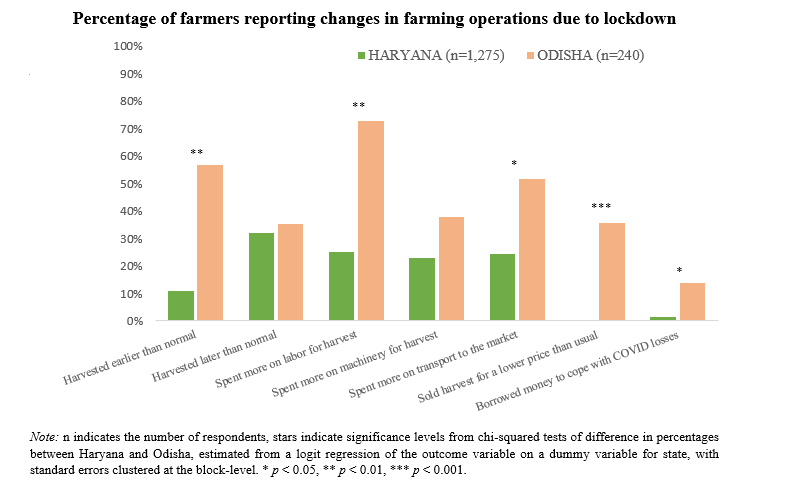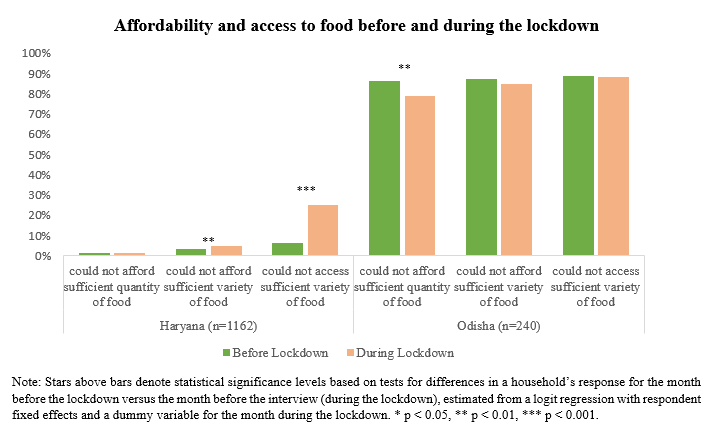Written by Francisco Ceballos, Samyuktha Kannan, and Berber Kramer
In early 2020, global alarms went off as a new virus threatened to take the lives of millions, prompting numerous countries into lockdown. Several months later, these and other restrictive measures remain, with economies worldwide finding themselves in dire straits. India, the 2nd most populous country and 6th largest economy in the world, and home to 126 million smallholder farmers, imposed one of the strictest lockdowns seen, with restrictions to the movement of people and goods at a time when farmers across several states were ready to harvest their crops.
In this context, and as part of an impact evaluation of a new type of crop insurance, we wanted to understand the impacts of COVID-19 related measures on smallholder livelihoods, and, where needed, adapt our intervention, or the theory of change that is being tested through our impact evaluation. Crop insurance is not the primary policy response to support farmers in the context of a lockdown, but the least we could do was to adjust our program design or adapt our theory of change to better match the new realities faced by targeted smallholder farmers.
Thus, closely after the lockdown was announced, we set out to measure disruptions to agricultural incomes and food security through phone-based surveys with more than 1,500 farmers in Haryana and Odisha, two states in India. A publication in World Development describes the markedly distinct experiences across the two states, in terms of both agricultural incomes and food security:
- Mechanization and large-scale public procurement of wheat protected farmers in Haryana from labor shortages and price fluctuations, whereas producers in Odisha faced an increase in labor costs and income losses due to challenges in marketing their crops.
- At the same time, in Haryana, food security was more severely disrupted than in Odisha, perhaps because of Odisha’s higher rates of food insecurity already prior to the lockdown, combined with higher production diversity and shorter value chains.
This blog describes these findings in more detail, and—moving beyond the forthcoming publication—discusses implications for the design of crop insurance programs in the two states.
Agricultural incomes
In understanding disruptions to agricultural incomes, it is important to note that there are key differences between the two states. In Haryana, farms are largely mechanized, and central government agencies engage in large-scale procurement of wheat, ensuring farmers a floor price or minimum support price (MSP) for their harvest. By contrast, Odisha exhibits a more diverse cropping system, with paddy, pulses, and oilseeds as prominent winter crops, and more reliance on manual labor than machinery. Public procurement is uncommon; pulses are typically sold to private traders at the farmgate, who in turn sell the produce in the open market.
The figure below shows the contrast in experiences of farmers in the two states. Farmers in Odisha (orange bars) reported an increase in labor and transport costs at the time of harvest, and—lacking access to well-functioning output markets—a reduction in prices for their produce. These farmers had to take on credit to cope with associated losses. Farmers in Haryana, on the other hand (green bars), were able to shift to more readily available, mechanized alternatives, and sell their harvest under a staggered procurement schedule during the lockdown, ensuring a minimum support price and thus protecting their profits.
These findings highlight how institutions can play a critical role in supporting smallholder farmers’ incomes, with public procurement shielding farmers in Haryana from adverse effects, and more pronounced lockdown-related disruptions for farmers in Odisha.

Food security
The phone surveys also asked farmers about the affordability and availability of different types of food during versus before the lockdown, to gain insights into changes in food insecurity over time. While in Haryana, the prevalence of food insecurity was very low before the lockdown, almost a quarter of farmers reported difficulties in accessing different kinds of food in the market, due to either unavailability or increased prices, during the lockdown.
In Odisha, overall food insecurity was much higher than in Haryana, but we find no significant further increase in food insecurity after the lockdown was imposed. If anything, more farmers could afford a sufficient quantity of food after the lockdown, perhaps because locally produced foods could no longer be sold in more distant markets. More diverse cropping patterns, shorter value chains, and a higher prevalence of homestead gardens may also have insulated farmers in Odisha from further food insecurity.
These findings highlight the importance of considering context when targeting policies to mitigate impacts of the pandemic on food security. One would need to target areas with lower production diversity and longer value chains, such as Haryana, differently from areas such as Odisha, where higher production diversity helps maintain availability of many types of foods.

Implications for crop insurance
Given these findings, how to adapt crop insurance, including the solutions studied through our research program, to support farmer risk management and resilience in the future? Crop insurance is not designed to cover the financial consequences of a pandemic and should hence not be the primary response to a lockdown. However, as governments seek to alleviate the welfare implications of disrupted agricultural value chains, how to adapt this financial instrument to at least contribute to recovery and improve preparedness for future calamities?
- Holistic approaches that provide more secure market access: Farmers in Odisha suffered uninsured income losses as they were exposed to the open market with fluctuating prices, jeopardizing our objective of promoting agricultural investments by de-risking agriculture. To build resilience, these farmers need more holistic solutions that not only cover weather risks, but also help stabilize prices, in order to establish a more enabling environment to invest in agriculture. One could for instance link farmers to institutional buyers of produce or provide insurance coverage for price risk; challenging endeavors, but a crisis like the COVID-19 pandemic underscores the importance of doing so.
- Promote investments in modern technologies: Our study finds that an increase in labor costs reduced profits for farmers in Odisha, who rely heavily on agricultural labor. Qualitative interviews highlighted how access to mechanized alternatives for scarce labor appeared crucial in shielding farmers in Haryana from labor shortages during the lockdown. Many studies have shown that crop insurance, by transferring risk to financial markets and reducing farmers’ risk exposure, can help expand access to credit and unlock profitable investments in agriculture; including investments in labor-reducing technologies. It is important to design insurance programs with that investment purpose in mind; programs need to be clear on how they unlock credit and investments.
- Rapid claims settlement to support coping with income losses: Dealing with income losses in the short term is a challenge for poor households. Farmers in Odisha, for instance, resorted to increased borrowing, increasing indebtedness and potentially bringing about future financial hardship. For a cash-constrained farmer, an inflow of cash has significant value; past literature shows that it helps avoid reliance on costly coping strategies including credit. As such, it is critical for crop insurance payouts to arrive timely. The use of technology—including the smartphone image-based solution that we are evaluating—will be important in speeding up claims settlement, especially when the movement of goods and people is restricted, since technology provides eyes on the ground in otherwise difficult-to-reach areas.
